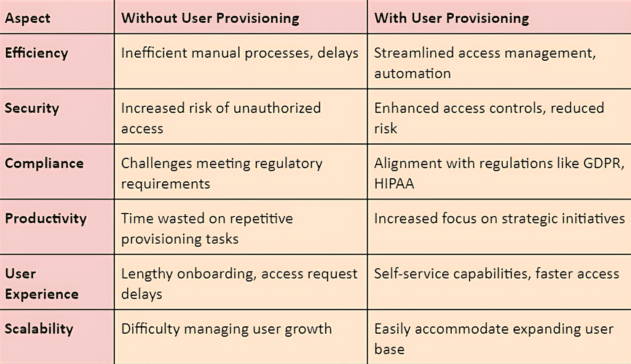Are you tired of juggling user accounts, access rights, and security risks within your organization? Do you spend countless hours on manual provisioning tasks, only to encounter delays, errors, and compliance headaches? If these challenges sound familiar, it’s time to recognize the critical role user provisioning plays in optimizing your business operations.
As a business leader, you understand the importance of streamlining processes, enhancing security, and staying ahead of the competition. Without an effective user provisioning strategy, your organization may become vulnerable to inefficiencies, data breaches and regulatory non-compliance.
In this article, let’s explore how you can harness the power of user provisioning to transform your operations, bolster security, and drive business growth. We’ll dive into advanced techniques, compliance considerations, integration solutions, and future trends that will help you take your user provisioning to the next level.
Strategic Overview of User Provisioning in Modern Business
As a business leader, it’s essential to understand the vital role user provisioning plays in ensuring operational efficiency and maintaining data security. Over 60% of IT professionals recognize the critical importance of user provisioning in achieving these goals.
Aligning your user provisioning strategy with your overall business objectives and IT initiatives creates a cohesive framework that supports your company’s growth and success. This strategic alignment optimizes resource allocation, streamlines processes, and ensures that your user provisioning efforts align with your organization’s mission and vision.
Advanced Techniques in User Provisioning
To fully optimize your operations, it is crucial to leverage advanced techniques in user provisioning. Automating user account management can streamline access and identity controls, reducing the time your team spends on manual tasks by up to 70%.
This not only boosts operational efficiency but also minimizes the risk of human error. Implementing automated provisioning workflows ensures that user accounts are created, updated, and deactivated in a timely and consistent manner, freeing up your IT staff to focus on more strategic initiatives.
User Provisioning and Compliance: Navigating the Regulatory Landscape
Compliance is likely a top priority for your organization. Effective user provisioning helps you navigate the complex regulatory landscape and ensures adherence to global standards.

Implementing a comprehensive user provisioning system can reduce non-compliance risks by up to 65%. This is particularly crucial when dealing with regulations such as GDPR and HIPAA, which have strict requirements for data protection and access control that directly impact your business.
To meet these regulatory requirements, your user provisioning system should include features such as audit trails, access reviews, and segregation of duties. These capabilities provide you with the necessary visibility and control to demonstrate compliance and protect sensitive data.
Integration Challenges and Solutions in User Provisioning Systems
Optimizing your user provisioning, integrating these systems with your existing IT infrastructure can be a daunting task. In fact, 80% of organizations report significant challenges in this area.
However, following best practices and adopting a strategic approach allows you to overcome these obstacles and achieve seamless integration. To ensure successful integration, it’s essential to assess your current IT landscape and identify potential compatibility issues.
Leveraging open standards and APIs facilitates smoother integration between your user-provisioning system and other applications. Additionally, partnering with experienced providers who offer comprehensive integration services can help you navigate the complexities and ensure a successful implementation.
Optimizing Your User Provisioning Framework: A Step-by-Step Guide
Embarking on the path to optimized user provisioning begins with a thorough assessment of your current practices. Identify areas for improvement within your organization and develop a phased approach for upgrading your systems. By breaking down the process into manageable steps, you can ensure a smooth transition and minimize disruptions to your operations.
Start by defining your user provisioning policies and procedures, taking into account your business requirements, security standards, and compliance obligations. Engage stakeholders from various departments to gather input and ensure alignment across your organization.
Next, evaluate your existing user provisioning tools and systems to determine if they meet your current and future needs. Consider factors such as scalability, integration capabilities, and ease of use. If necessary, explore new solutions that can better support your optimized provisioning framework.
Once you have selected the appropriate tools and systems, focus on implementing automated workflows and self-service capabilities. Automating routine provisioning tasks reduces manual effort, minimizes errors, and improves efficiency. Self-service portals empower users to manage their own access requests, freeing up IT resources and enhancing the user experience.
Throughout the optimization process, don’t forget to prioritize training and communication. Ensure that your IT staff and end-users are well-versed in the new provisioning processes and tools. Provide clear guidelines and support channels to facilitate adoption and minimize resistance to change.
Finally, establish metrics and key performance indicators (KPIs) to measure the success of your optimized user provisioning framework. Regularly monitor and report on these metrics to demonstrate the value and impact of your efforts. Continuously gather feedback from stakeholders and users to identify areas for further improvement and ensure ongoing success.
Final Thoughts
Optimizing operations through effective user provisioning is no longer a luxury—it’s a necessity for your organization. By leveraging advanced techniques, navigating compliance requirements, overcoming integration challenges, and embracing future trends, you can position your business for long-term success. Don’t let inefficient user provisioning hold you back. Take action today to harness the power of user provisioning and propel your company to new heights.
Ready to optimize your operations with cutting-edge user provisioning solutions? Contact our team of experts today to schedule a consultation and discover how we can help you streamline your processes, enhance security, and drive business growth.
FAQs
1. What is user provisioning in business?
User provisioning involves the management of user access to enterprise resources, ensuring employees have the necessary permissions to perform their roles efficiently.
2. How does user provisioning enhance security?
By controlling access rights, user provisioning helps prevent unauthorized access, reducing the risk of internal and external security breaches.
3. Can user provisioning reduce operational costs?
Yes, automating user access controls through provisioning can significantly lower administrative overhead and reduce IT operational costs.
Published by: Nelly Chavez










